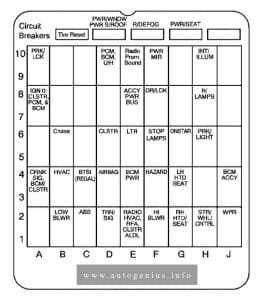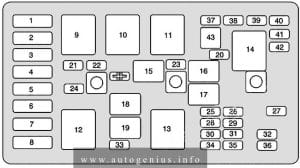Buick Century (VI; 2004 – 2005) – fuse and relaybox diagram
Year of production: 2004, 2005
This article covers the Buick Century. It includes fuse box diagrams for the 6th generation 2004 and 2005 models, provides details on the location of the fuse panels inside the vehicle, and explains the function and layout of each fuse.
Passenger compartment
Fuse box location
The fuse box is located on right side of the instrument panel, behind the cover.
Fuse box diagram

Assignment of the fuses in the passenger compartment
| Circuit Breakers | Usage |
| TIRE RESET | Tire Inflation Monitor Reset Button |
| PWR/WNDW PWR S/ROOF | Power Windows, Power Sunroof |
| R/DEFOG | Rear Window Defogger |
| PWR/ SEAT | Power Seat |
| Blank | Not Used |
| Fuses | Usage |
| PRK/LCK | Ignition Key Solenoid |
| Blank | Not Used |
| Blank | Not Used |
| PCM, BCM, U/H | Ignition Signal: Hot in Run and Start, Powertrain Control Module, Body Control Module, Underhood Relay |
| RADIO PREM. SOUND | Not Used |
| PWR MIR | Power Mirrors |
| Blank | Not Used |
| INT/ILLUM | Panel Dimming |
| Blank | Not Used |
| IGN 0: CLSTR, CM & BCM | Ignition Signal: Hot in Run, Unlock and Start; Cluster, Powertrain Control Module, Body Control Module |
| Blank | Not Used |
| Blank | Not Used |
| Blank | Not Used |
| ACCY PWR BUS | Interior Lamps |
| DR/ LCK | Door Locks |
| Blank | Not Used |
| R/LAMPS | Taillamps, License Plate Lamps |
| Blank | Not Used |
| Blank | Not Used |
| CRUISE | Cruise Control |
| Blank | Not Used |
| CLSTR | Instrument Panel Cluster |
| LTR | Cigarette Lighter |
| STOP LAMPS | Stoplamps |
| ONSTAR | OnStar® |
| PRK/LGHT | Parking Lamps |
| Blank | Not Used |
| CRNK SIG, BCM, CLSTR | Crank Signal, Body Control Module, Cluster, Powertrain Control Module |
| HVAC | Ignition Signal, Heating, Ventilation, and Air Conditioning Control Head |
| BTSI (REGAL) | Not Used |
| AIR BAG | Air Bag |
| BCM PWR | Body Control Module |
| HAZARD | Hazard Warning Flashers |
| LH HTD SEAT | Not Used |
| Blank | Not Used |
| BCM ACCY | Ignition Signal: Hot in ACCESSORY and RUN, Body Control Module |
| Blank | Not Used |
| LOW BLWR | Low Blower |
| ABS | Anti-Lock Brakes |
| TRN SIG | Turn Signals, Cornering Lamps |
| RADIO, HVAC, RFA, CLSTR ALDL | Radio, Heating Ventilation and Air Conditioning Head; Remote Keyless Entry, Cluster |
| HI BLWR | High Blower |
| RH HTD SEAT | Not Used |
| STR/WHL/ CNTRL | Audio Steering Wheel Controls |
| WPR | Windshield Wipers |
Engine compartment
Fuse box location
Some fuses and relays are located in the underhood fuse block on the passenger’s side of the vehicle in the engine compartment.
Fuse box diagram

Assignment of the fuses in the engine compartment
| Fuses | Usage |
| 1 | Anti-Lock Brake System |
| 2 | Starter Solenoid |
| 3 | Power Seat, Rear Window Defogger |
| 4 | High Blower, Hazard Flasher, Stoplamps, Power Mirror, Door Locks |
| 5 | Ignition Switch, Stoplamps, Anti-Lock Brake System, Turn Signals, Cluster, Air Bag, Daytime Running Lamps Module |
| 6 | Cooling Fan |
| 7 | Retained Accessory Power, Remote Keyless Entry, Data Link, Heating, Ventilation, and Air Conditioning Head; Cluster, Radio, Cigarette Lighter |
| 8 | Ignition Switch, Wipers, Audio Steering Wheel Controls, Body Control Module, Power Windows, Sunroof, Heating, Ventilation, and Air Conditioning Controls; Daytime Running Lamps, Rear Window Defogger Relay |
| Relays | Usage |
| 9 | Cooling Fan 2 |
| 10 | Cooling Fan 3 |
| 11 | Starter Solenoid |
| 12 | Cooling Fan 1 |
| 13 | Ignition Main |
| 14 | Air Pump (Optional) |
| 15 | Not Used |
| 16 | Horn |
| 17 | Fog Lamps |
| 18 | Not Used |
| 19 | Fuel Pump |
| Fuses | Usage |
| 20 | Not Used |
| 21 | Generator |
| 22 | Engine Control Module |
| 23 | Air Conditioner Compressor Clutch |
| 24 | Cooling Fan |
| 25 | Electronic Ignition |
| 26 | Transaxle |
| 27 | Horn |
| 28 | Fuel Injector |
| 29 | Oxygen Sensor |
| 30 | Engine Emissions |
| 31 | Fog Lamps |
| 32 | Right Headlamp |
| 33 | Rear Compartment Release |
| 34 | Parking Lamps |
| 35 | Fuel Pump |
| 36 | Left Headlamp |
| 37 | Not Used |
| 38 | Not Used |
| 39 | Not Used |
| 40 | Not Used |
| 41 | Not Used |
| 42 | Not Used |
| 43 | Not Used |
| Air Conditioner Compressor Clutch Diode |
WARNING: Terminal and harness assignments for individual connectors will vary depending on vehicle equipment level, model, and market.
